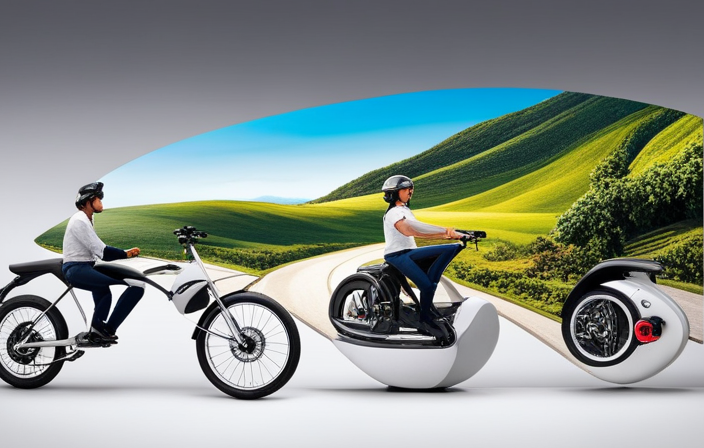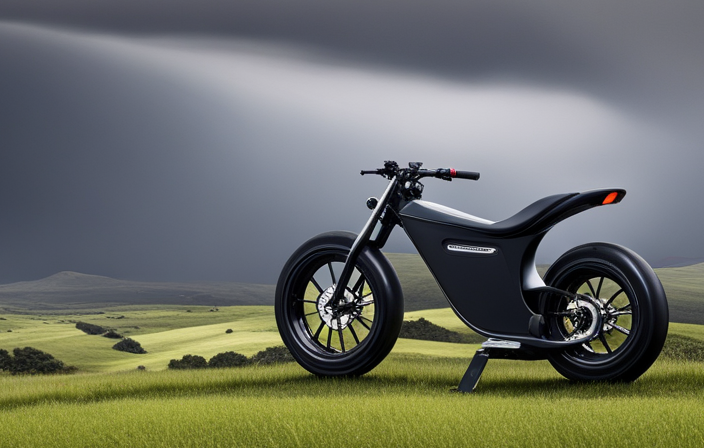Are you ready to embark on the exciting journey of purchasing an electric bike? Let me share a story with you.
Imagine this: you’re a commuting enthusiast, seeking a reliable and efficient mode of transportation. You want to find the perfect electric bike that suits your riding style and needs.
In this article, I will guide you through the essential factors to consider, from budget and frame type to motor and battery capacity. With this knowledge, you’ll be equipped to make an informed decision and enjoy the exhilarating experience of owning an electric bike.
Key Takeaways
- Determine your riding style and needs before choosing an electric bike.
- Consider your budget and choose an electric bike that fits within your price range.
- Evaluate the braking system and ensure it meets your needs for stopping power.
- Pay attention to the bike components, such as frame materials, motor power, and battery, to ensure they meet your specific needs and preferences.
Determine Your Riding Style and Needs
Before you start shopping for an electric bike, take a moment to really think about your riding style and what you need from your new two-wheeled companion.
There are different types of electric bike riding styles, and it’s important to choose one that aligns with your preferences and requirements.
If you enjoy leisurely rides through the city or park, a cruiser electric bike might be the perfect fit.
For those seeking adventure and off-road capabilities, a mountain electric bike would be more suitable.
Factors to consider when determining your electric bike needs include the terrain you’ll be riding on, the distance you plan to travel, and the level of assistance you desire from the motor.
By understanding your riding style and needs, you can make a more informed decision when choosing the right electric bike for you.
Now let’s consider your budget and find the perfect ride.
Consider Your Budget
When thinking about your budget for an e-bike, it’s important to consider the overall cost. Electric bikes can range in price from a few hundred dollars to several thousand dollars, depending on the features and specifications.
Riding style considerations are also important when determining your budget. If you plan on using your e-bike for shorter commutes or leisurely rides, you may not need all the bells and whistles that come with higher-end models. There are budget-friendly options available that still offer reliable performance and durability. These bikes may have fewer features or a less powerful motor, but they can still provide a comfortable and enjoyable riding experience.
Transitioning into the next section about choosing the right frame type, it’s important to find a balance between your budget and the specific features you need in an e-bike.
Choose the Right Frame Type
Finding the perfect frame type for your e-bike will make every ride feel like a thrilling adventure. When choosing the right frame type, consider your riding preferences and the frame material.
If you prefer a more upright and comfortable riding position, a step-through frame is a great choice. This type of frame allows for easy mounting and dismounting, making it ideal for urban commuting or leisurely rides.
On the other hand, if you enjoy a more aggressive and sporty riding style, a diamond frame will provide better stability and efficiency.
Additionally, consider the frame material, such as aluminum or carbon fiber, which affects the bike’s weight, durability, and ride quality.
Now, let’s move on to the next section and decide on the motor type for your electric bike.
Decide on the Motor Type
When it comes to deciding on the motor type for an electric bike, there are two main options to consider: hub motors and mid-drive motors.
Hub motors are known for their simplicity and affordability, as they are built directly into the wheel.
On the other hand, mid-drive motors offer better performance and efficiency, as they are positioned near the bike’s bottom bracket and provide power directly to the drivetrain.
Both options have their own advantages, and understanding the differences between them can help you make an informed decision on which motor type is best suited for your needs.
Hub Motors for Simplicity and Affordability
If you’re looking for a no-fuss option that won’t break the bank, hub motors might just be the ticket. These motors are built directly into the wheel hub, making them incredibly simple and easy to maintain.
One of the biggest advantages of hub motors is their affordability. They tend to be less expensive compared to other types of electric bike motors. Additionally, hub motors provide a smooth and quiet ride, as there are no additional drivetrain components involved.
However, there are some disadvantages to consider. Hub motors can add extra weight to the bike, affecting its handling and maneuverability. They also tend to have lower torque, which can make climbing steep hills a bit more challenging.
Moving on to mid-drive motors for better performance and efficiency, let’s explore their advantages and features.
Mid-Drive Motors for Better Performance and Efficiency
For an exhilarating ride with optimal performance and efficiency, you’ll love the power and versatility of mid-drive motors.
Mid-drive motors offer several advantages over hub motors, making them a popular choice among electric bike enthusiasts. Unlike hub motors that are built into the wheel, mid-drive motors are positioned at the bike’s center, near the pedals. This placement allows for better weight distribution and balance, resulting in improved handling and maneuverability.
Additionally, mid-drive motors provide better torque and power, making them ideal for tackling steep hills and rough terrains. They also offer a wider range of gear options, allowing riders to maintain a comfortable and efficient cadence.
So, if you’re looking for an electric bike that delivers superior performance and efficiency, a mid-drive motor is the way to go.
Now, let’s check battery capacity and range.
Check Battery Capacity and Range
To ensure that you can travel long distances without worrying about the battery running out, it’s worth considering an electric bike with a larger battery capacity and extended range. A larger battery capacity means you can go further without needing to recharge, while an extended range ensures you won’t have to constantly search for charging stations.
When choosing an electric bike, keep the following in mind:
-
Battery life: Look for bikes with batteries that have a long lifespan and can hold their charge for extended periods. This will ensure you can rely on your bike for daily commutes or long rides without constantly worrying about running out of power.
-
Charging time: Consider how quickly the battery can be recharged. Look for bikes that offer fast charging options so you can get back on the road in no time.
Considering the bike’s weight and portability is also important. By choosing a bike that is lightweight and easy to transport, you can enjoy the convenience of taking it on public transportation or storing it in small spaces.
Consider the Bike’s Weight and Portability
Don’t let the burden of a heavy and cumbersome ride hold you back from experiencing the freedom and convenience of effortless transportation. When considering what electric bike to buy, it is crucial to take into account the bike’s weight and portability.
Opting for a lightweight electric bike will not only make it easier to maneuver through traffic and tight spaces, but it will also enhance the overall riding experience. Additionally, a lighter bike is more suitable for storage and transportation, allowing you to effortlessly carry it up stairs or fit it into a compact space. However, it is important to strike a balance between weight and durability to ensure the bike can withstand daily use and occasional bumps.
Now, let’s look at the braking system and how it contributes to the overall safety of your electric bike.
Look at the Braking System
When it comes to ensuring a safe and reliable ride, the braking system of your electric bike is a crucial factor to consider. The importance of brake type and quality cannot be overstated. There are different types of braking systems available, such as rim brakes, disc brakes, and regenerative braking. Each has its own pros and cons.
Rim brakes are affordable and lightweight, but they can wear down the rim over time. Disc brakes, on the other hand, provide excellent stopping power and work well in wet conditions, but they can be more expensive. Regenerative braking is a unique feature that converts the kinetic energy of the bike into electrical energy, which can then be used to recharge the battery. However, it may not be as effective in stopping the bike compared to traditional brakes.
Considering the braking system is essential for a safe ride. Moving forward, let’s evaluate the suspension system of the electric bike.
Evaluate the Suspension System
When evaluating the suspension system of an electric bike, it is important to consider the type of terrain you will be riding on.
Full suspension is ideal for those who plan to tackle rough terrain, as it provides a comfortable and smooth ride by absorbing the impact of bumps and obstacles.
On the other hand, front suspension is beneficial for enhancing control and stability, particularly when navigating through corners or uneven surfaces.
Both options have their own advantages depending on your specific needs and preferences.
Full Suspension for Comfort on Rough Terrain
Riding a full suspension electric bike feels like gliding effortlessly over rough terrain. The combination of an electric motor and a full suspension system provides a smooth and comfortable ride, improving shock absorption and minimizing the impact of bumps and obstacles. Here are three benefits of riding a full suspension electric bike:
- Enhanced comfort: The dual suspension system, consisting of both front and rear shocks, absorbs vibrations and bumps, providing a more comfortable ride even on uneven surfaces.
- Improved traction: With both wheels staying in contact with the ground more consistently, full suspension bikes offer better traction, allowing you to maintain control and stability on rough terrain.
- Reduced fatigue: The improved shock absorption of a full suspension electric bike reduces the strain on your body, allowing you to ride longer without feeling as fatigued.
Transitioning into the subsequent section about front suspension, it is important to consider the benefits of a front suspension system for enhanced control and stability.
Front Suspension for Enhanced Control and Stability
To truly feel in command of your journey, picture yourself effortlessly gliding through challenging terrain with a front suspension system, enhancing control and stability.
Front suspension benefits include improved handling on rough surfaces, better traction, and reduced impact on your body, making it ideal for off-road adventures. It absorbs shocks and bumps, allowing you to maintain your balance and ride comfortably.
Additionally, front suspension enhances steering precision, giving you better control over your bike. However, it’s important to consider the drawbacks as well.
Front suspension can add weight to the bike, making it less efficient on smoother surfaces. It can also increase the cost of the bike.
Therefore, when choosing an electric bike, pay attention to the bike’s components to ensure they meet your specific needs and preferences, such as motor power, battery capacity, and frame design.
Pay Attention to the Bike’s Components
It’s important to consider the bike’s components when choosing which electric bike to purchase. One crucial aspect to pay attention to is the bike frame materials. Different materials, such as aluminum or carbon fiber, can greatly affect the bike’s weight, durability, and overall performance.
Another important component to consider is the motor power and torque. The motor determines how much assistance the bike provides, and the torque determines the bike’s ability to climb hills and handle different terrains. A powerful motor and high torque can make your rides more enjoyable and effortless.
Additionally, other components like the brakes, gears, and battery should also be taken into account. These components can greatly impact the bike’s overall performance and your riding experience.
Considering all these factors will help you make an informed decision when choosing the right electric bike for your needs. Now, let’s move on to the next step and test ride and compare different models.
Test Ride and Compare Different Models
Now that you’ve considered the bike’s components, it’s time to hop on and compare different models through test rides. Here are four key aspects to pay attention to during your test ride experience:
-
Comfort: Pay attention to how the bike feels as you ride it. Is the seating position comfortable? Is the frame size suitable for your height? Remember, you’ll be spending a significant amount of time on this bike, so comfort is crucial.
-
Power and Performance: Test the electric bike’s power and performance by taking it for a spin on different terrains. Does it handle hills effortlessly? Does it provide a smooth and steady ride? Compare the power levels and battery life of different models to ensure it matches your needs.
-
Handling and Stability: Ride the bike through corners and turns to assess its handling and stability. Does it feel steady and balanced? Is it easy to maneuver? These factors are essential for a safe and enjoyable riding experience.
-
Price and Value: Compare prices of the different models you test ride. Consider the features, components, and overall quality of each bike to determine its value for the price.
By comparing these aspects during your test rides, you’ll be able to make an informed decision about which electric bike to choose.
Now, let’s move on to the next section where we’ll discuss how to read reviews and consider recommendations.
Read Reviews and Consider Recommendations
After test riding and comparing different models, it’s time to dive into reviews and consider recommendations from experienced riders.
Reading reviews is a crucial step in the process of finding the perfect electric bike. By considering user experiences, you can gain valuable insights into the pros and cons of each model. Look for reviews that mention the bike’s performance, battery life, ease of use, and overall quality.
It’s also worth seeking professional advice from experts in the field, such as bike shop owners or electric bike enthusiasts. These individuals can provide valuable guidance based on their knowledge and experience.
Once you have gathered enough information from reviews and recommendations, it’s time to move on to the next step and research the brand’s reputation and customer service.
Research the Brand’s Reputation and Customer Service
To ensure a smooth and satisfying experience with your chosen brand, take the time to research their reputation and customer service. This will help you feel confident in your decision.
When it comes to brand reputation, consider factors such as how long the company has been in business, their track record of producing quality electric bikes, and their overall standing in the industry. Look for customer reviews and ratings to gauge customer satisfaction.
A brand with a strong reputation and positive customer feedback is more likely to provide reliable products and excellent customer service. This will give you peace of mind knowing that any potential issues or concerns will be addressed promptly and efficiently.
By researching the brand’s reputation and customer service, you can make an informed decision and choose a brand that will meet your needs and expectations.
Moving forward, it is also important to check for warranty and after-sales support to ensure a comprehensive buying experience.
Check for Warranty and After-Sales Support
Make sure you find a brand that offers a comprehensive warranty and reliable after-sales support, as this will ensure a smooth and worry-free ownership experience for you.
When researching electric bikes, it is crucial to check the warranty coverage provided by the brand. A good warranty should cover all major components, including the battery and motor, for a reasonable period of time.
Additionally, consider the customer service quality of the brand. Look for reviews and testimonials from other customers to gauge their satisfaction with the brand’s after-sales support. A responsive and helpful customer service team can make a significant difference in resolving any issues or concerns you may have.
By choosing a brand with a solid warranty and excellent customer service, you can have peace of mind knowing that you will be well taken care of in case of any problems.
Moving forward, it is also essential to consider maintenance and repair costs.
Consider Maintenance and Repair Costs
Now that we have checked for warranty and after-sales support, let’s move on to the next important consideration when choosing an electric bike: maintenance and repair costs. It’s crucial to factor in the ongoing expenses associated with owning an electric bike, as they can vary significantly depending on the brand and model. To help you make an informed decision, I have created a table below comparing the estimated maintenance costs for three popular electric bike brands over a three-year period:
| Brand | Average Yearly Maintenance Cost | Total Maintenance Cost (3 years) |
|---|---|---|
| Brand A | $200 | $600 |
| Brand B | $150 | $450 |
| Brand C | $250 | $750 |
Regular servicing is essential to keep your electric bike in optimal condition and prevent costly repairs. By following the manufacturer’s recommended maintenance schedule and addressing any issues promptly, you can prolong the lifespan of your electric bike and minimize unexpected expenses. Now, let’s move on to the next section and learn how to make an informed decision and enjoy your electric bike.
Make an Informed Decision and Enjoy Your Electric Bike
When choosing your electric ride, it’s crucial to consider all factors so you can fully enjoy the benefits and avoid any unexpected surprises along the way. Did you know that 80% of electric bike owners report higher levels of satisfaction compared to traditional bikes?
Here are some riding techniques and safety tips to help you make an informed decision and enjoy your electric bike:
-
Practice proper body positioning: Keep your weight centered and balanced to maintain control and stability.
-
Use the right gear: Adjust your gears according to the terrain and your desired speed to optimize performance.
-
Be aware of traffic: Always follow traffic rules and signals, and stay alert to the movement of vehicles around you.
-
Maintain a safe distance: Keep a safe distance from other cyclists, pedestrians, and vehicles to avoid accidents.
-
Wear protective gear: Always wear a helmet and consider additional safety equipment like knee and elbow pads for added protection.
By following these riding techniques and safety tips, you can maximize your enjoyment and safety while riding your electric bike.
Frequently Asked Questions
How long does it take to fully charge the battery of an electric bike?
It typically takes around 4-6 hours to fully charge the battery of an electric bike. Regular electric bike battery maintenance is essential to prolong its life and ensure optimal performance. Owning an electric bike offers numerous benefits, such as eco-friendliness and cost savings on fuel.
Can I ride an electric bike in the rain?
Yes, you can ride an electric bike in the rain. However, it is important to take precautions such as using fenders, waterproofing the electrical components, and maintaining the bike properly to prevent damage. Riding an electric bike in snowy conditions requires additional precautions and specialized tires for better traction.
Are electric bikes allowed on bike paths and trails?
Yes, electric bikes are allowed on bike paths and trails, but it’s important to understand the electric bike regulations and safety concerns. I’ll provide you with detailed information on these topics to ensure a safe and enjoyable riding experience.
How much does it cost to replace the battery of an electric bike?
Replacing the battery of an electric bike can cost anywhere from $200 to $800, depending on the brand and model. Upgrading the battery can provide benefits such as increased range and power, making it worth considering.
What is the average lifespan of an electric bike?
The average lifespan of an electric bike can vary depending on several factors. Factors such as battery quality, maintenance, usage frequency, and terrain can all affect how long an electric bike will last.
Conclusion
After carefully considering my riding style, budget, frame type, motor type, battery capacity, and brand reputation, I have finally made a decision on which electric bike to buy.
The statistic that stood out to me during my research was that electric bikes can cover an average range of 40-60 miles on a single charge. This impressive range allows me to explore the city and enjoy long rides without worrying about running out of battery.
I can’t wait to hit the road and experience the thrill of riding my new electric bike!









